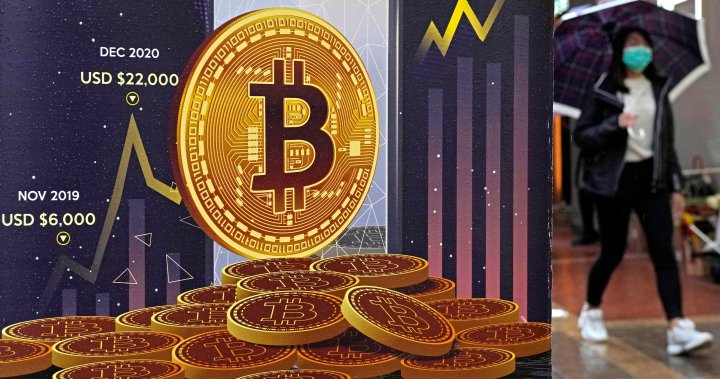Bitcoin’s price hit a new high on Tuesday after a months-long rally, the latest step on a volatile journey for the world’s largest cryptocurrency.
Analysts who spoke to Global News say it’s an opportunity for investors to consider whether bitcoin, and crypto more broadly, has a role to play alongside assets like gold in their portfolio.
Bitcoin hit an all-time high of US$69,202 in intraday trading on Tuesday, topping the previous peak of US$68,999.99 from November 2021. It then retreated from those highs to float around US$65,000 by noon eastern.
Bitcoin’s overall rise of nearly 160 per cent since October 2023, of which 44 per cent came in February alone, marks a sharp contrast to 2022, when the market was beaten into an 18-month-long crypto winter, plagued by a string of high-profile corporate bankruptcies and scandal.
But a turnaround in bitcoin’s prospects came with a long-awaited regulatory approval in the new year.
Driving some of the run-up in prices at the end of 2023 was anticipation that the Securities and Exchange Commission in the United States would soon approve bitcoin exchange-traded funds (ETFs).
That paid off on Jan. 10 when the securities regulator south of the border gave the all-clear to BlackRock, the world’s largest asset manager, to open one of 11 spot bitcoin ETFs given the go-ahead that same day.
Exchange-traded funds allow investors to get exposure to an entire basket of securities, like stocks, bonds and other assets, without having to own them outright. Experts compare the bitcoin ETF to funds for gold, allowing investors to get exposure to the commodity without having to store it in a safety deposit box, for example.
Though bitcoin ETFs have been approved for years in Canada and launched last year in Europe, U.S. adoption has opened the floodgates to demand for the asset, Greg Taylor says.
Taylor is the chief investment officer at Purpose Investments, which launched the world’s first bitcoin ETF in 2021.
With the ETF, Taylor tells Global News that investors curious about bitcoin get exposure to the asset in their portfolio without needing to understand how to open and manage a digital wallet on a crypto exchange – similar to the gold and safety deposit box example.
“Now there’s a lot more demand for bitcoin and it’s a lot easier for people to get access to,” he says. “This is really opening up to the largest investor base in the world, the U.S. retail investor.”
While much of the appreciation in price heading into 2024 was tied to the anticipation around a rumoured spot bitcoin ETF approval, Alex Tapscott, portfolio manager at Ninepoint Partners, says the funds have thus far lived up to the hype.
Financial news and insights
delivered to your email every Saturday.
Net flows into the 10 largest U.S. spot bitcoin funds reached US$2.17 billion in the week to March 1, with more than half of that going into BlackRock’s iShares Bitcoin Trust, according to the London Stock Exchange Group.
In the past few weeks, bitcoin ETFs have been handling trading volumes behind only the S&P 500 and Nasdaq ETFs, Tapscott says.
“Other than the largest U.S. equity ETFs … the bitcoin ETFs are beating everybody else out,” he says. “That’s just inevitably going to put pressure on the price because there’s an excess of demand.”
There’s another event on the horizon that has investors in the cryptocurrency space excited.
Every four years, the bitcoin market undergoes a “halving” that essentially cuts the production of new bitcoin in half. The next halving is scheduled for April 2024.
The price of bitcoin has historically increased following a halving. Taylor says that’s because of a sense of scarcity in bitcoin after the production capacity from the miners that generate the token gets cut in half.
A halving scheduled at the same time as the new bitcoin ETFs are taking off is likely to put more of a crunch on supply as demand has been ramping up, Taylor explains.
“That’s generally bullish,” he says.
Tapscott is quick to point out that bitcoin having previously seen its price appreciate in the wake of a halving doesn’t mean it’s going to happen again in April.
There’s a chance that price spikes after a halving have become a “self-fulfilling prophecy” of sorts, he says, with investor interest just tending to pick up when there’s a notable event in the market like that.
“I still don’t think it’s clear that the halving itself has any true impact, but the perception around it does clearly increase interest in the asset,” Tapscott says.
In addition to demand from a wider pool of investors, bitcoin, and crypto generally, has gotten a boost from the prospect of the U.S. Federal Reserve cutting interest rates, which often prompts investors to divert capital into assets that are higher yielding or more volatile.
“One part of (bitcoin’s rally) has to do with the generally positive sentiment on risk in general,” said Alvin Tan, head of Asia FX strategy at RBC Capital Markets, according to Reuters. “You can see that in the all-time high in the S&P 500 and Nasdaq.”
Investors have lapped up crypto, mega-cap technology stocks and investment-grade corporate bonds in particular this year.
Also on Tuesday, gold struck a record high, moving further above US$2,100 per ounce in a rally sparked by growing bets for a U.S. interest rate cut in June.
Taylor says investors are looking for “something that can be a little different” from traditional bonds and equities, which explains shifts towards gold and real estate. He lumps cryptocurrency among those “real assets” that could perform well as alternatives to traditional securities.
“With having bitcoin ETFs a little more established and easier to access, more people are saying, ‘Well, maybe I should have a little bit of my portfolio in this,’” he says.
Taylor notes that the nature of bitcoin has not changed, and that it remains “volatile.” But he says the asset has also proven its staying power, bouncing back from the disastrous 2022 when some analysts had written the cryptocurrency off completely.
“It’s acting right now like a commodity that’s going to be around longer-term,” he says. “I think investors need to keep on their radar screen, and maybe when they feel comfortable with it, having a little bit of exposure in their portfolio is not a bad thing.”
Taylor notes that it’s not necessarily time to “blindly” buy into crypto amid the hype of record highs.
If investors are looking for an opportunity, however, he says the second most popular cryptocurrency, ethereum, is lagging behind bitcoin’s gains. There’s speculation as well that an ethereum ETF is next up for approval in the U.S., which could see it catch up to its big sibling, bitcoin.
“If anyone wants to play the lead-lag trade, looking at ethereum might be something that they should consider in their portfolio as well,” Taylor says.
Tapscott says investors looking to ride the ascent of bitcoin might take a cue from another hot prospect in equity markets, artificial intelligence.
Nvidia’s market capitalization has soared in recent weeks on the back of lofty expectations for the chipmaker and AI powerhouse. Tapscott says that in the same way that investors might look to other companies powering the AI revolution after Nvidia’s takeoff, markets might start to pay attention to other investment opportunities in blockchain technology following bitcoin’s rise.
Rallies like this can be a “double-edged sword,” Tapscott warns, where some companies get a lift just because of a loose association with the crypto space. While he is a firm believer in the next suite of innovations tied to blockchain and “web3” applications, Tapscott warns there is still no shortage of risks in the market.
“When the tide goes out, as Warren Buffett would say, you’ll see who’s swimming naked,” he says. “And I think a lot of people might lose money as a result. This is a reality of what happens during these speculative periods.”
– with files from Global News’s Anne Gaviola, Reuters




